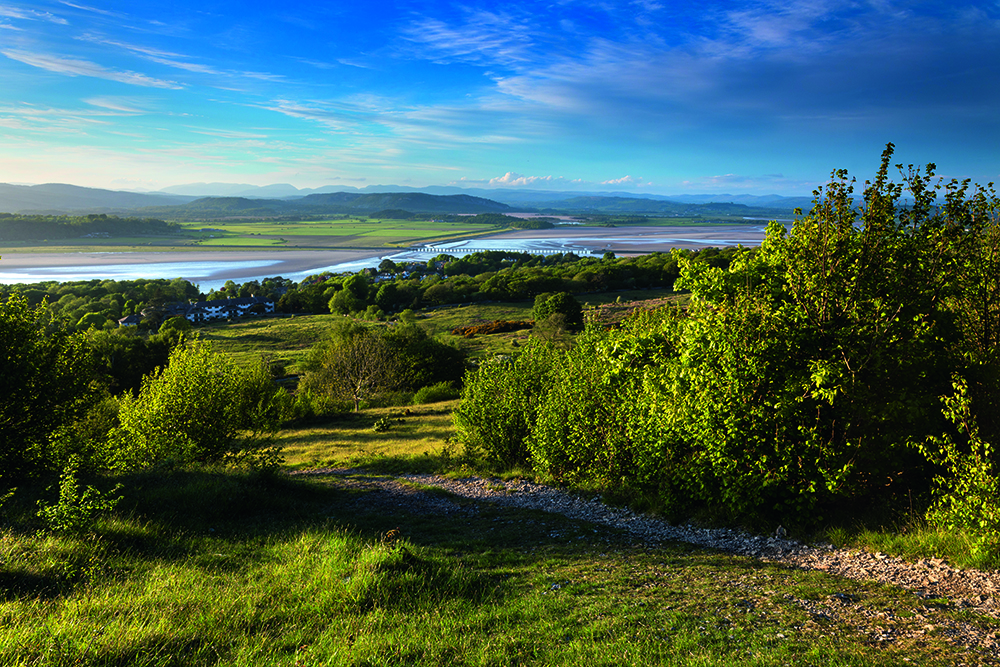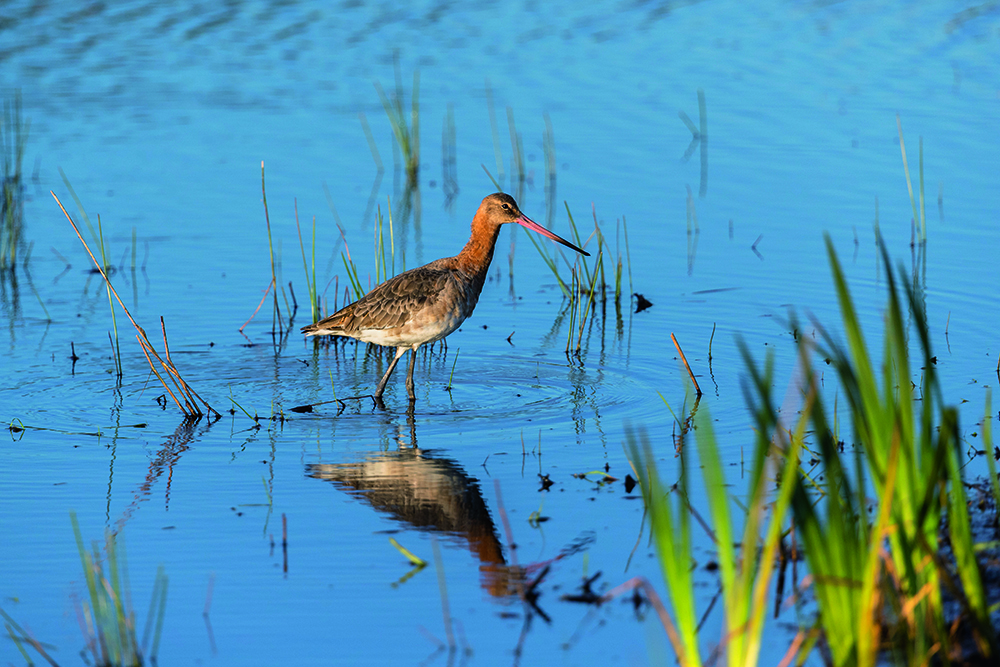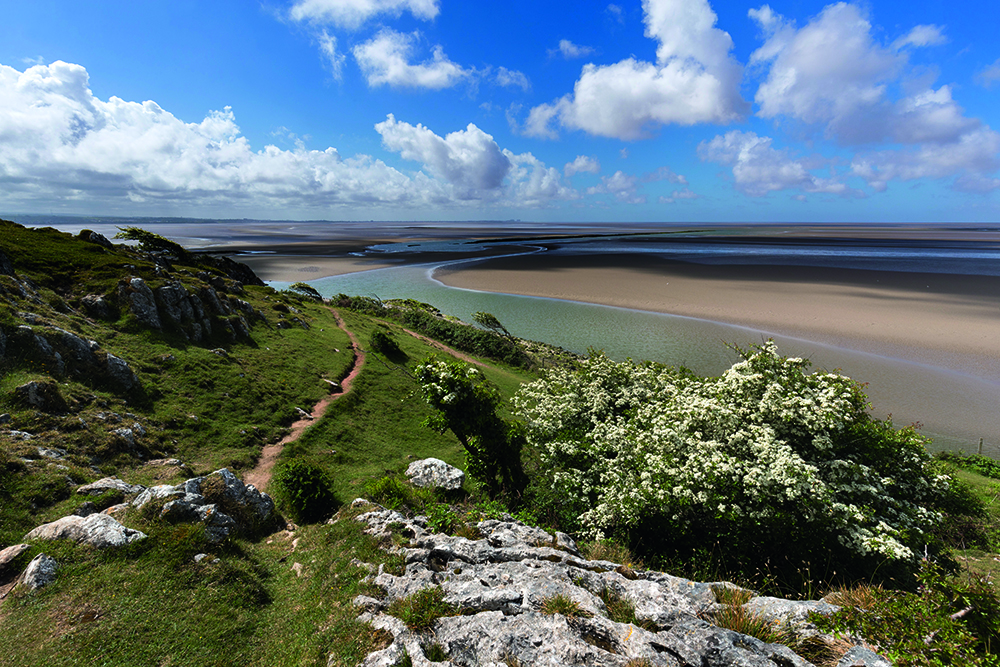Motorhome travel: Wildlife-spotting in the Northwest of England
When I suggested a wildlife-spotting trip to the Arnside and Silverdale AONB (Area of Outstanding Natural Beauty) to my wife, Sarah, she looked at me and said, “There can’t be enough wildlife in an area as small as that!” Well, this AONB, straddling the border of Lancashire and Cumbria, has always been one of my favourites. It’s great for wildlife, so I took Sarah’s comment as a challenge...

One of the most notable nature reserves of the area is RSPB Leighton Moss, which has a fantastic reputation. It’s only a 15-minute walk from the Hawes Villa campsite to the Leighton Moss visitor centre, so we had a few coffees and cakes there in between exploring the many hides and paths around the reserve.
The bird on the emblem of the Arnside and Silverdale AONB is a bittern and it is at Leighton Moss that bitterns might be found, though they are not as regular as they once were. With this in mind, the RSPB has purchased two plots of land in the region and is creating reedbeds specifically for the bitterns. One of these is at Ings Point and the other on Silverdale Moss.
Leighton Moss does have a staggering amount of wildlife and seven hides from which to watch. On the main reserve I had several sightings of marsh harriers, an otter, several red deer, lots of black-tailed godwits, bearded tits, Cetti’s warblers and even a couple of cattle egrets. Whilst I was there a total of three ospreys visited the reserve but I failed to connect with any of them. These birds nest outside the AONB at Foulshaw Moss, but regularly visit Leighton Moss to find fish.

Other birds common to the reserve include plenty of ducks, geese and a wide range of warblers. Talking of warblers, I visited the saltmarsh section of the reserve by making a walk, which cut across the marsh from Heald Brow, near Silverdale. On the path to the Eric Morecambe hide (yes, he was a keen birdwatcher) I saw nine species of warbler: sedge warbler, reed warbler, whitethroat, lesser whitethroat, grasshopper warbler, willow warbler, chiffchaff, Cetti’s warbler and blackcap. At Heald Brow I also saw garden warblers and redstarts. This hints at the richness of this area for breeding migrant birds.
Despite the wonders of Leighton Moss it wasn’t really birdwatching that attracted me to visit in late May. This AONB is very important for butterflies and flowers. Throughout the area there are plenty of early purple orchids and at The Lots, a National Trust meadow, there is a large colony of the much rarer green-winged orchids, distinguished by the green veining in the ‘wings’ over the central petal of each flower.
One of the most amazing spectacles we came across was a wood crammed full of ramsons at Fleagarth, near Heald Brow. This is a limestone area so there are many lime-loving flowers to be found. For instance, cowslips are abundant in May. On the limestone pavements it is possible to see some quite special flowers including Solomon’s seal, rockrose, lily of the valley and a few very rare species.
One of the best limestone pavements in the area is at Gait Barrows, a National Nature Reserve just a stone’s throw from Hawes Villa campsite – and this was the main reason for me choosing that site. Gait Barrows is renowned for its abundant butterflies and flowers. I was very keen to see the superb lady’s slipper orchid. This spectacular orchid is a mega-rarity in the UK and a real gem.

Timing is everything with flowers and, though seasons vary, I suggest the last two weeks of May and the first week of June are best for lady’s slipper orchids. This reserve has a wonderful selection of flowers including a huge amount of lily of the valley and some great old yew trees and juniper bushes. It also has a selection of scarce butterflies including, in May, the pearl-bordered fritillary, duke of burgundy fritillary and dingy skipper. Later in the year it is possible to see high brown fritillary, though it would seem that most of these species are declining even at this site where every care is taken to provide exactly what they need. It is thought that climate is likely to be having an impact on their success.
At the foot of the reserve is the largest natural lake in Lancashire, rather confusingly called Hawes Water (since there is a lake of the same name in Cumbria). The Hawes Villa site has special access to a jetty, which affords lovely views over this reed-fringed lake and, though leaflets suggest marsh harrier and bittern occur here, I saw only reed buntings, reed and sedge warblers and I heard the distinctive squealing of water rails.
Probably the other best limestone outcrop is at Warton Crag. Parking isn’t great with a height restriction on the quarry car park, but there are a range of possible options for creating a walk from Hawes Villa. Warton Crag is thought to be the best location in the area for pearl-bordered fritillaries and the habitat is being actively managed to support them and high brown fritillaries by coppicing woodland to help violets flourish.
Birdlife is also similar in that we saw garden warblers and redstarts in the scrubby areas, but there is the added bonus of two very special nests in the quarry. The raven’s nest was no longer in use; that family had been successful in raising three young and we watched them flying over the crag, croaking and honking as they went. Still under occupation was the peregrine’s nest; high on the quarry face, it took a telescope to get a good view. F
.jpg)
For the second part of our week we moved to the New Barns Caravan Park near Arnside. This, too, had a great location, adjacent to the Kent Estuary and Arnside Knott, but unfortunately, it doesn’t have any touring pitches now. The Knott is regarded as being another great place for butterflies, most notably the high brown fritillaries in early July. The woodland around Heathwaite and at nearby Eaves Wood is very rich in common breeding birds such as treecreeper, nuthatch, marsh tit and both great spotted and green woodpeckers.
We took one day out to walk along the estuary through Arnside, Sandside as far as Dallam – where we cut inland to Beetham – and back via Fairy Steps and Arnside Tower. The estuary is fairly quiet in the spring, but we saw a few common waders including curlews, redshanks, oystercatchers, lapwings and a couple of whimbrels. Little egrets were active and well as plenty of grey herons. The most entertaining bird was the shelduck. Even this late in the spring I watched a flock of males mobbing one poor female. They squabbled with each other, tried to impress her with incessant head-bobbing and either ran, swam or flew after her in an attempt to win her over. She was having none of it!
At the eastern end of Sandside, opposite the entrance to a small industrial estate, the footpath leads down to a saltmarsh. On the verge just before the start of the path there is a wonderful range of plants and insects. In late May this patch was full of flowers including the distinctive twayblade (a type of orchid). I found several burnet moth caterpillars eating the leaves of bird’s foot trefoil and there were plenty of bumblebees feeding on the various flowers. A greater prize than any of those was the beautiful and intricate fly orchid, of which I believe there can be many flower spikes in good years. It’s astonishing how such a small unpromising spot can offer so much beauty to wonder at.
The third species of deer for the AONB was spotted in the deer park at Dallam. These fallow deer are captive but it is nice to see them and even nicer to have a lovely lunch at the Old Post Office in the village of Beetham at the climax of a long walk. Our return route was through Fairy Steps. It is a very relaxed place which boasts, as a tourist attraction, a narrow gap between two slabs of limestone. The story goes that if you can descend the steps without touching the sides the fairies will grant you a wish.






.jpg)


Recent Updates
Engine management lights: all you need to know
What is the engine management light? What does it mean, and what do I have to do? ...
Motorhome air suspension: all you need to know
Motorhomes are heavy and the additional weight of equipment and height of the bodywork can increase the loads ...
Motorhome WiFi: how to get better motorhome internet
Staying connected on the move is more and more essential, so relying on campsite WiFi isn't an option – here ...
A class of their own - our guide to A-class motorhomes
Thinking of trading up to an A-class, or even going straight to the top of the motorhome tree? We guide you ...
Explore overseas on a motorhome dream tour
Enjoy exotic travel in a campervan or motorhome by hiring, swapping with someone else or exporting your ...
Motorhome water systems: everything you need to know
On-board water is an important part of every motorhome – here’s everything you need to know ...
Campervanning in Europe: what you need to know
Whether you're planning a leisurely drive through the French countryside, navigating bustling city streets in ...
Campervan security: all you need to know
With thefts on the increase, it’s important to know how to keep your campervan secure and prevent campervan ...
Campervan furniture: everything you need to know
Our campervan experts guide you through all the essentials for your campervan, including tables, chairs, ...
Campervan finance: how to fund your purchase
Here we look at the different types of campervan finance available, to help you decide what’s the best option ...
Other Articles
Britain’s best used motorhomes
Want a great motorhome without paying the premium for a new one? Here's a guide to the best you can get in the pre-owned market for each layout, ...
Which motorhome? Choosing the perfect motorhome for you
Choosing a motorhome or campervan is one of the biggest buying decisions you’ll ever make, so it's important ...
Campervan washroom essentials: stay fresh on the road
Our guide will take you through the campervan washroom essentials you'll need so you're well-prepared for ...
Dogs in campervans: all you need to know
Follow our advice and your dog will enjoy campervanning as much as you do ...
Electric campervans: all you need to know
Our guide will take you through everything you need to know about electric campervans and what the future ...
Motorhome electrics: a complete guide to your motorhome electrical set-up
Motorhome electrics can dramatically enhance the convenience and comfort of your vehicle – but they can be ...
Lighting for campervans: all you need to know
We guide you through all the lighting options available for you and your campervan, including interior ...
Electric bikes for motorhomes: our ultimate guide
Read our comprehensive guide to electric bikes for motorhome owners, helping you add electric power to your ...
Our guide to 'cheap' motorhomes in 2024
If you're on the hunt for an affordable new motorhome, this is the best place to start – we've rounded up a ...
Campervans in winter: all you need to know
Here's your guide to preparing your campervan for the colder months, whether you will be using it or putting ...